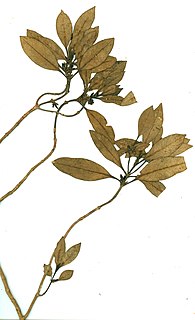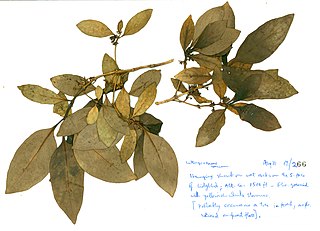
Passiflora herbertiana, or native passionfruit, is a widespread climbing twiner native to moist forests on the coast and ranges of eastern Australia. The subspecies P. h. insulae-howei is endemic to Lord Howe Island in the Tasman Sea.

Pterostylis curta, commonly known as the blunt greenhood, is a species of orchid found in south-eastern Australia, Lord Howe Island and New Caledonia. It has a rosette of leaves at its base and a single white and green, forward leaning flower with a brown tip and a twisted labellum.

Melaleuca howeana, commonly known as tea tree, is a plant in the myrtle family, Myrtaceae and is endemic to the Lord Howe Island group, 600 km (400 mi) off the east coast of Australia. It is common in exposed areas, on cliffs and ridges, occasionally forming pure stands. Its closest mainland relative is Melaleuca ericifolia.

Drypetes deplanchei is a tree of eastern and northern Australia. It also occurs in New Caledonia and Lord Howe Island. The genus is derived from the Greek, dryppa meaning "olive fruit". The species named after Dr. Emile Deplanche, who collected this plant at New Caledonia. Common names include yellow tulip, grey boxwood, white myrtle, grey bark and yellow tulipwood.

Sarcomelicope simplicifolia, commonly known as bauerella, hard aspen or yellow-wood, is a species of flowering plant in the family Rutaceae and is endemic to eastern Australia including Lord Howe and Norfolk Islands. It is a shrub or small tree with elliptic to egg-shaped leaves arranged in opposite pairs, male or female flowers arranged in small groups in leaf axils and fruit an oval to spherical drupe.

Persoonia media is a species of flowering plant in the family Proteaceae and is endemic to eastern Australia. It is an erect to spreading shrub or tree with branchlets and leaves that are glabrous or only sparsely hairy, elliptic to egg-shaped leaves and up to sixteen yellow flowers on a rachis up to 150 mm (5.9 in) long.
Lepidium nesophilum is a flowering plant in the mustard and cabbage family. The specific epithet is derived from the Greek nesos (“island”) and -philus (“loving”), alluding to its island home.

Lepidium howei-insulae , commonly known as mustard & cress, is a flowering plant in the mustard and cabbage family. The specific epithet alludes to Lord Howe Island, where it is found.
Westringia viminalis is a flowering plant in the mint family. The specific epithet refers to its long, slender shoots. It is closely related to Westringia fruticosa, which is found on coastal heath and cliffs in New South Wales.

Rapanea platystigma is a flowering plant in the family Primulaceae. The specific epithet comes from the Greek platys (“broad”) and stigma, with reference to the relatively broad stigma.

Metrosideros sclerocarpa, commonly known as the mountain rose, is a flowering plant in the myrtle family.

Coprosma huttoniana is a flowering plant in the family Rubiaceae. The specific epithet honours Ian Hutton, the Lord Howe Island based naturalist who discovered the plant and recognised it as a new species.
Coprosma inopinata is a flowering plant in the family Rubiaceae. The specific epithet comes from the Latin inopinus (“unexpected”), because it was discovered unexpectedly in 1989, proving to be yet another species of Coprosma that was endemic to Lord Howe Island.

Coprosma lanceolaris is a flowering plant in the family Rubiaceae. The specific epithet comes from the Latin lancea with the suffix -aris, alluding to the shape of the leaves.

Coprosma prisca, commonly known as goatwood, is a flowering plant in the family Rubiaceae. The Latin specific epithet prisca means “old” or “ancient”, though its application to this species is unknown.
Melicope contermina is a species of shrub or small tree in the family Rutaceae and is endemic to Lord Howe Island. It has trifoliate leaves and white flowers borne in leaf axils in panicles of nine to fifteen flowers.
Leptospermum polygalifolium subsp. howense, commonly known as tea tree or tea-tree, is a flowering plant in the myrtle family, Myrtaceae. The subspecific epithet refers to the island to which the subspecies is endemic.
Passiflora herbertiana subsp. insulae-howei is a flowering plant in the passion flower family. The subspecific epithet refers to the island to which the subspecies is endemic.

Wahlenbergia capillaris, commonly known as tufted bluebell, is a plant in the family Campanulaceae and is native to Australia and New Guinea. It is an erect perennial herb with a few to many stems and grows to a height of 50 cm (20 in). The leaves are mostly linear with a few scattered teeth on the sides and the flowers are blue, bell-shaped with five lobes and arranged in cymes. This bluebell is widespread and common, occurring in all Australian mainland states and territories.

Wahlenbergia capensis, commonly known as the Cape bluebell, is a plant in the family Campanulaceae and is native to the Cape Province but has been introduced to Australia. It is an annual herb with up to four greenish blue, bell-shaped flowers with spreading petal lobes.














